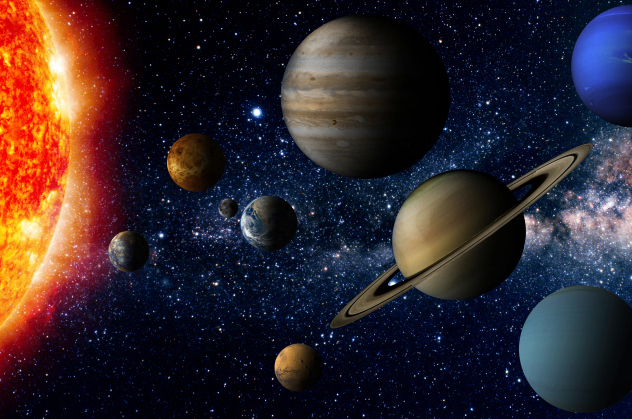Although space science has made many new advances, with the support of advanced technology, there are still mysteries that we cannot explain.
Although space science has made many new advances, with the support of advanced technology, there are still mysteries that we cannot explain. Not far away, but right in our solar system, there are still many mysteries.
1. The invisible shield around the Earth
In 1958, James Van Allen at the University of Iowa discovered a pair of radiation belts around the Earth, at a distance of 40,000 km from the ground. These belts contain high-energy electrons and protons. These are the energetic particles emitted by the Sun, and during times of strong solar activity, also known as solar storms, the number and energy level of these particles increase even more.
These high-energy particles and radiation are invisible killers, and can also affect satellites and electronic systems on Earth. However, most of them cannot reach the Earth’s surface, some higher-energy particles can penetrate deeper into the atmosphere, but all must stop at a distance of 11,000 km from the ground.
Scientists believe that there is an invisible wall that prevents these energy particles from entering the Earth. It is similar to the invisible energy shield in science fiction movies like Star Wars. However, why the Earth has such a shield is still an unsolved mystery. Many hypotheses suggest that the Earth’s magnetic field is the reason high-energy particles cannot penetrate inside, but this hypothesis still faces many objections.
2. Abnormal horizontal flight phenomenon
Ever since humans began sending satellites and spacecraft into space, scientists have been using the gravitational force of planets, like centrifugal force, to help create extra thrust for space exploration. It’s a bit like tying a rope to a rock and then spinning it around to throw it farther.
However, when applying this method, scientists noticed a strange phenomenon. That is, the rotational speed of a spacecraft or satellite around a planet is unstable. It is called the phenomenon of irregular flyby. Meanwhile, in theory, the rotational speed should gradually increase or decrease with a stable acceleration according to scientists’ calculations.
In reality, NASA’s Cassini spacecraft, launched into Earth’s orbit in 1999, sometimes accelerates and sometimes decelerates abnormally as it orbits the Earth. Many hypotheses have been put forward, including the hypothesis about dark matter remaining in the Solar System. It is like a region of dense matter that cannot be observed. When the spacecraft passes through this region of matter, it will slow down like a bullet flying from air to liquid.
3. Great Red Spot on Jupiter
During the first observation of Jupiter, scientists discovered a mysterious large red circular spot in the atmosphere of this planet. Its size is large enough to fit 2 Earths, and it continues to move above Jupiter’s atmosphere. Until now, scientists have not been able to know what it is, but only know that it appeared a long time ago.
There have been many hypotheses to explain what it is, as well as its formation and why it is so large and brick-red. Among them, many scientists believe that it is a giant storm, it was formed a long time ago and on its way it absorbed other small storms. Like a mini black hole to continue to exist and grow.
The red color of the storm is due to the material on Jupiter’s surface being sucked into the storm. However, another theory suggests that the sunlight reflects along with some chemicals in Jupiter’s atmosphere such as ammonia and acetylene, causing it to appear red. Currently, this mysterious red streak continues to move and grow.
4. Weather on Saturn’s moon Titan
Titan is Saturn’s only moon, and interestingly, it has seasons just like Earth. Each season on Titan lasts about 7 Earth years, because it takes Saturn 29 years to complete one orbit around the Sun. The last seasonal change on Titan was in 2009, when winter in the Northern Hemisphere turned to spring and summer in the Southern Hemisphere just ended.
However, around May 2012, during Titan’s southern hemisphere autumn, scientists spotted images of a massive vortex with a diameter of up to 300km. This is something that would not have happened in the warm conditions in the southern hemisphere at that time.
Meanwhile, using spectroscopy, scientists have detected signs of frozen hydrogen cyanide (HCN) particles inside the atmosphere of this storm. Meanwhile, to form these frozen HCN particles, the temperature must be 100 degrees Celsius lower than normal. That means the weather on Titan has had a strange reversal.
Scientists have not yet been able to explain this mystery. There is no hypothesis, because the number of planets with seasonal distributions similar to Earth is very rare. Meanwhile, this phenomenon is also extremely special. It makes scientists fear that the same thing could happen to Earth.
5. High-energy cosmic rays
Cosmic rays, high-energy radiation that is unlike the radiation from the Sun, are one of the mysteries that scientists are still studying. Until now, we still do not know where these cosmic rays come from, nor why they have such great energy.
On Earth, scientists have also recorded such cosmic rays shining directly into our atmosphere. But thanks to an invisible shield, these rays do not affect humans or electronic devices on the Earth’s surface. These cosmic rays carry the highest energy particles we have ever seen in the universe.
It is hypothesized that these cosmic rays come from very large explosions due to the formation, collapse or collision of large stars outside the Milky Way. However, according to observations, the appearance of these cosmic rays does not coincide with any cosmic phenomenon that we can observe.
















